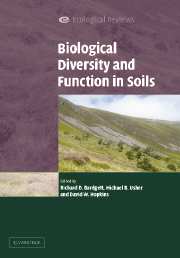Preface
Published online by Cambridge University Press: 17 September 2009
Summary
Soil has generally been treated as something of a ‘black box’ by ecologists. It provides the physical support for plants, and both the living and non-living components contribute to a variety of important environmental functions. These include decomposition and the recycling of nutrients, which are both key functions in terrestrial ecosystems. Other roles, such as the breakdown of pollutants and the storage of bioelements, have immense applied significance in a changing environment. Soil provides a habitat for many species of bacteria, fungi, protists and animals; it is generally recognised as a habitat that is species rich. But many questions about the ecological significance of the soil's biological diversity, and in particular how it affects ecosystem function, have never been asked. Until fairly recently this has been because the linkages between above-ground ecology, which is rich in ecological theory, and below-ground ecology, where investigation has been restricted by methodological difficulties, have not been made. It is now time to open the ‘black box’ and to start to understand how it works.
At the end of the twentieth century and with the start of the twenty-first century, efforts have been going on around the world to gain a greater understanding of the diversity of life in the soil and of the functions that these many species perform. In the UK there have been two major programmes of research on biological diversity and the function of soil ecosystems.
- Type
- Chapter
- Information
- Biological Diversity and Function in Soils , pp. xiii - xivPublisher: Cambridge University PressPrint publication year: 2005

